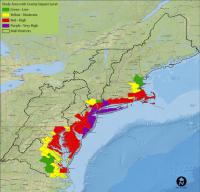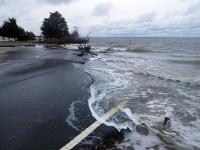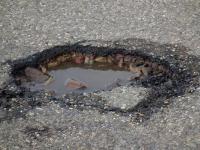-
Expanding use of recycled water would benefit the environment, human health
More than 1 in 9 people around the world, about 750 million, do not have access to safe, clean drinking water, and the problem is expected to worsen in step with rising greenhouse gas concentrations, population increases and climate change. Researchers found that found that recycled water has great potential for more efficient use in urban settings and to improve the overall resiliency of the water supply.
-
-
New fuel materials to make nuclear reactors safer
Nuclear power is an important energy source in the United States and around the world and is essential as a clean energy to reduce current carbon emissions from fossil fuels. However, many people feel the risk of nuclear accidents does not outweigh the benefits associated with nuclear energy. Scientists are exploring new materials for nuclear fuel, which could make current light water reactors (LWRs) safer.
-
-
Researchers crack 50-year-old nuclear waste problem, making waste storage safer
Researchers have adapted a technology developed for solar energy in order to selectively remove one of the trickiest and most-difficult-to-remove elements in nuclear waste pools across the country, making the storage of nuclear waste safer and nontoxic — and solving a decades-old problem. The scientists figure out how to remove americium from nuclear waste pools, opening the door for expanding the use of one of the cleanest and efficient energy sources on the planet.
-
-
We still don’t really know the health hazards of a nuclear accident
Five years after the nuclear disaster in Fukushima and thirty years after the Chernobyl accident, scientists are still disagreeing about the impact on human health — such as how many people have got cancer as a result and how dangerous the exclusion zones currently are. The people of Fukushima, except those in the worst contaminated areas, will eventually be encouraged to return to their homes. In the absence of better understanding, scientific and political arguments about how safe the radiation levels are will continue. What is abundantly clear, though, is that we need to understand the comparative health effects of radiation versus relocation. Developing a new approach in our response to nuclear accidents and the decisions that are made in their immediate aftermath is vital so that we can avoid unnecessary panic and evacuation — something virtually all scientists agree on.
-
-
FEMA rejects Michigan governor's request for more Flint money
The Federal Emergency Management Agency (FEMA) has again rejected a request from Michigan governor Rick Snyder for additional federal assistance to address the lead poisoning in Flint, Michigan’s water supply. The contamination disaster was caused by a Snyder-appointed city manager’s decision to shut down the city’s access to water filtration systems as a cost-cutting measure.
-
-
“Acceptable risk” is a better way to think about radiation exposure in Fukushima
Five years after the Fukushima disaster, many of these people remain refugees, unable to return home for fear of radiation exposure. As the radioactivity cleanup continues, people are coming to an uncomfortable realization: although cleanup can reduce the level of radioactive contamination, the environmental radiation dose levels within the prefecture will remain elevated for many generations before they finally reach the very low levels that existed prior to the accident. So, when will it be safe for people to return to their homes and to normal life in the Fukushima Prefecture? With regard to radiation exposure, “safe” really means an “acceptable level of risk,” and not everyone agrees on what is acceptable. Providing people with this risk characterization information, at the very least, is within the power of all radiation regulatory agencies, even if achieving complete cleanup of the environment is beyond their reach. This public information void about radiation risks needs to be filled. People can make their own decisions once they’re empowered with credible and intelligible risk information.
-
-
Up to 70 percent of Northeast U.S. coast likely to adapt to rising seas

Much of the coast from Maine to Virginia is more likely to change than to simply drown in response to rising seas during the next seventy years or so, according to a new study led by the U.S. Geological Survey. The study is based on a new computer model that captures the potential of the Northeast coast to change, driven by geological and biological forces, in ways that will reshape coastal landscapes.
-
-
Helping policymakers plan for sea level rise

A new study could help protect more than thirteen million American homes that will be threatened by rising sea levels by the end of the century. It is the first major study to assess the risk from rising seas using year 2100 population forecasts for all 319 coastal counties in the continental U.S. Previous impact assessments use current population figures to assess long-term effects of coastal flooding. The data can help policymakers develop practical adaptation strategies for protecting land threatened by frequent and repeated inundation.
-
-
Fertilizer applied to fields today will contaminate water for decades
Nitrogen fertilizer applied to farmers’ fields has been contaminating rivers and lakes and leaching into drinking water wells for more than eighty years. Dangerous nitrate levels in drinking water could persist for decades, increasing the risk for blue baby syndrome and other serious health concerns.
-
-
Microwave repairs might annihilate zombie potholes once and for all

Some potholes are like zombies – they never die. Or at least that’s the perception of much of the driving public, especially as we enter peak pothole season: late winter and early spring. Recurring “zombie” potholes are too often a reflection of the type of method that’s used to patch or “fix” them – many of which are short-lived and only marginally effective. Researchers around the world are working to develop better and longer lasting repair alternatives. Microwave technology is not yet a routine method of repair, and it’s best-suited for potholes in asphalt rather than concrete. But this approach merits further consideration. After all, given our nation’s aging network of roads, zombie potholes will continue to flourish. Microwave repair could be an effective method for keeping them at bay.
-
-
U.S. files case against Iranian government hackers behind attack on N.Y. dam

In 2013 hackers infiltrated the operations center for the Bowman Avenue Dam, a small dam on Blind Brook in Rye Brook, New York. DHS, in a classified report, later identified the attackers r identified the attackers as the same Iranian group responsible for attacks on PNC Financial Services Group, SunTrust, and Capital One Financial. Now the Department of Justice is set to file an indictment against the Iranian hackers behind the intrusion.
-
-
Radioactive strontium, cesium from Fukushima continue to leak to the ocean
Scientists investigated the levels of radioactive strontium and cesium in the coast off Japan in September 2013. Radioactive levels in seawater were 10 to 100 times higher than before the nuclear accident, particularly near the facility, suggesting that water containing strontium and cesium isotopes was still leaking into the Pacific Ocean.
-
-
News coverage of Fukushima disaster inadequate
Five years after the 2011 Fukushima Daiichi nuclear disaster in Japan, the disaster no longer dominates U.S. news headlines, although experts say it is a continuing disaster with broad implications. A new analysis finds that U.S. news media coverage following the disaster minimized health risks to the general population.
-
-
The lasting legacies of Chernobyl and Fukushima
It is thirty years since the Chernobyl nuclear disaster. It is also five years since the Fukushima disaster. Greenpeace says that to mark these anniversaries, it has commissioned reviews of scientific studies examining the continued radioactive contamination in the affected areas, and the health and social effects on the impacted populations.
-
-
Warmer spring temperatures reduce Colorado River flows
Warmer-than-average spring temperatures reduce upper Colorado River flows more than previously recognized, according to a new report. The study, the first to examine the instrumental historical record, discovers that temperature has played a larger role in streamflow and in exacerbating drought since the 1980s.
-
- All
- Regional
- Water
- Biometrics
- Borders/Immig
- Business
- Cybersecurity
- Detection
- Disasters
- Government
- Infrastructure
- International
- Public health
- Public Safety
- Communication interoperabillity
- Emergency services
- Emergency medical services
- Fire
- First response
- IEDs
- Law Enforcement
- Law Enforcement Technology
- Military technology
- Nonlethal weapons
- Nuclear weapons
- Personal protection equipment
- Police
- Notification /alert systems
- Situational awareness
- Weapons systems
- Sci-Tech
- Sector Reports
- Surveillance
- Transportation
Advertising & Marketing: advertise@newswirepubs.com
Editorial: editor@newswirepubs.com
General: info@newswirepubs.com
2010-2011 © News Wire Publications, LLC News Wire Publications, LLC
220 Old Country Road | Suite 200 | Mineola | New York | 11501
Permissions and Policies
Editorial: editor@newswirepubs.com
General: info@newswirepubs.com
2010-2011 © News Wire Publications, LLC News Wire Publications, LLC
220 Old Country Road | Suite 200 | Mineola | New York | 11501
Permissions and Policies
